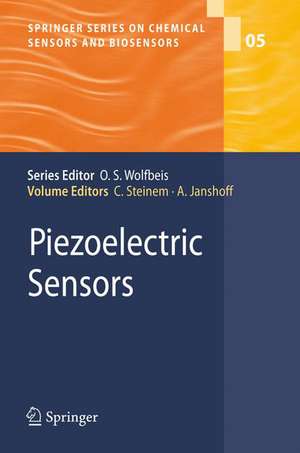Piezoelectric Sensors: Springer Series on Chemical Sensors and Biosensors, cartea 5
Editat de Claudia Steinem, Andreas Janshoffen Limba Engleză Hardback – 4 ian 2007
| Toate formatele și edițiile | Preț | Express |
|---|---|---|
| Paperback (1) | 1819.87 lei 6-8 săpt. | |
| Springer Berlin, Heidelberg – 23 noi 2010 | 1819.87 lei 6-8 săpt. | |
| Hardback (1) | 1826.20 lei 6-8 săpt. | |
| Springer Berlin, Heidelberg – 4 ian 2007 | 1826.20 lei 6-8 săpt. |
Din seria Springer Series on Chemical Sensors and Biosensors
- 9%
 Preț: 1108.89 lei
Preț: 1108.89 lei - 18%
 Preț: 2098.81 lei
Preț: 2098.81 lei - 18%
 Preț: 956.03 lei
Preț: 956.03 lei - 18%
 Preț: 1817.85 lei
Preț: 1817.85 lei - 18%
 Preț: 1216.16 lei
Preț: 1216.16 lei - 18%
 Preț: 1216.02 lei
Preț: 1216.02 lei - 18%
 Preț: 1822.57 lei
Preț: 1822.57 lei - 24%
 Preț: 1045.39 lei
Preț: 1045.39 lei - 18%
 Preț: 2484.74 lei
Preț: 2484.74 lei - 18%
 Preț: 2476.54 lei
Preț: 2476.54 lei - 18%
 Preț: 954.77 lei
Preț: 954.77 lei - 18%
 Preț: 955.08 lei
Preț: 955.08 lei - 15%
 Preț: 639.69 lei
Preț: 639.69 lei - 15%
 Preț: 696.35 lei
Preț: 696.35 lei - 24%
 Preț: 781.37 lei
Preț: 781.37 lei - 18%
 Preț: 1217.90 lei
Preț: 1217.90 lei - 5%
 Preț: 1097.54 lei
Preț: 1097.54 lei
Preț: 1826.20 lei
Preț vechi: 2227.07 lei
-18% Nou
Puncte Express: 2739
Preț estimativ în valută:
349.46€ • 373.68$ • 291.36£
349.46€ • 373.68$ • 291.36£
Carte tipărită la comandă
Livrare economică 17 aprilie-01 mai
Preluare comenzi: 021 569.72.76
Specificații
ISBN-13: 9783540365679
ISBN-10: 3540365672
Pagini: 484
Ilustrații: XII, 484 p. 200 illus.
Dimensiuni: 155 x 235 x 32 mm
Greutate: 0.87 kg
Ediția:2007
Editura: Springer Berlin, Heidelberg
Colecția Springer
Seria Springer Series on Chemical Sensors and Biosensors
Locul publicării:Berlin, Heidelberg, Germany
ISBN-10: 3540365672
Pagini: 484
Ilustrații: XII, 484 p. 200 illus.
Dimensiuni: 155 x 235 x 32 mm
Greutate: 0.87 kg
Ediția:2007
Editura: Springer Berlin, Heidelberg
Colecția Springer
Seria Springer Series on Chemical Sensors and Biosensors
Locul publicării:Berlin, Heidelberg, Germany
Public țintă
ResearchCuprins
Physical Aspects of QCM-Measurements.- Interface Circuits for QCM Sensors.- Interface Circuits for QCM Sensors.- Studies of Viscoelasticity with the QCM.- Studies of Viscoelasticity with the QCM.- Probing the Solid/Liquid Interface with the Quartz Crystal Microbalance.- Probing the Solid/Liquid Interface with the Quartz Crystal Microbalance.- Studies of Contact Mechanics with the QCM.- Studies of Contact Mechanics with the QCM.- Chemical and Biological Applications of the QCM.- Imprinted Polymers in Chemical Recognition for Mass-Sensitive Devices.- Imprinted Polymers in Chemical Recognition for Mass-Sensitive Devices.- Analytical Applicationsof QCM-based Nucleic Acid Biosensors.- Analytical Applications of QCM-based Nucleic Acid Biosensors.- Piezoelectric Immunosensors.- Piezoelectric Immunosensors.- Specific Adsorption of Annexin A1 on Solid Supported Membranes: A Model Study.- Specific Adsorption of Annexin A1 on Solid Supported Membranes: A Model Study.- The Quartz Crystal Microbalance in Cell Biology: Basics and Applications.- The Quartz Crystal Microbalance in Cell Biology: Basics and Applications.- Applications Based on Advanced QCM-Techniques.- Enzyme Reactions on a 27 MHz Quartz Crystal Microbalance.- Enzyme Reactions on a 27 MHz Quartz Crystal Microbalance.- The Quartz Crystal Microbalance and the Electrochemical QCM: Applications to Studies of Thin Polymer Films, Electron Transfer Systems, Biological Macromolecules, Biosensors, and Cells.- The Quartz Crystal Microbalance and the Electrochemical QCM: Applications to Studies of Thin Polymer Films, Electron Transfer Systems, Biological Macromolecules, Biosensors, and Cells.- The QCM-D Technique for Probing Biomacromolecular Recognition Reactions.- The QCM-D Technique for Probing Biomacromolecular RecognitionReactions.- Resonant Acoustic Profiling (RAP™) and Rupture Event Scanning (REVS™).- Resonant Acoustic Profiling (RAP™) and Rupture Event Scanning (REVS™).
Caracteristici
Aimed at researchers and technologists in academic and industrial environments, as well as graduate students in chemistry, physics, biology, engineering, and material science who want to keep abreast of the latest trends in chemical sensing and biosensing with piezo-electric sensor devices








